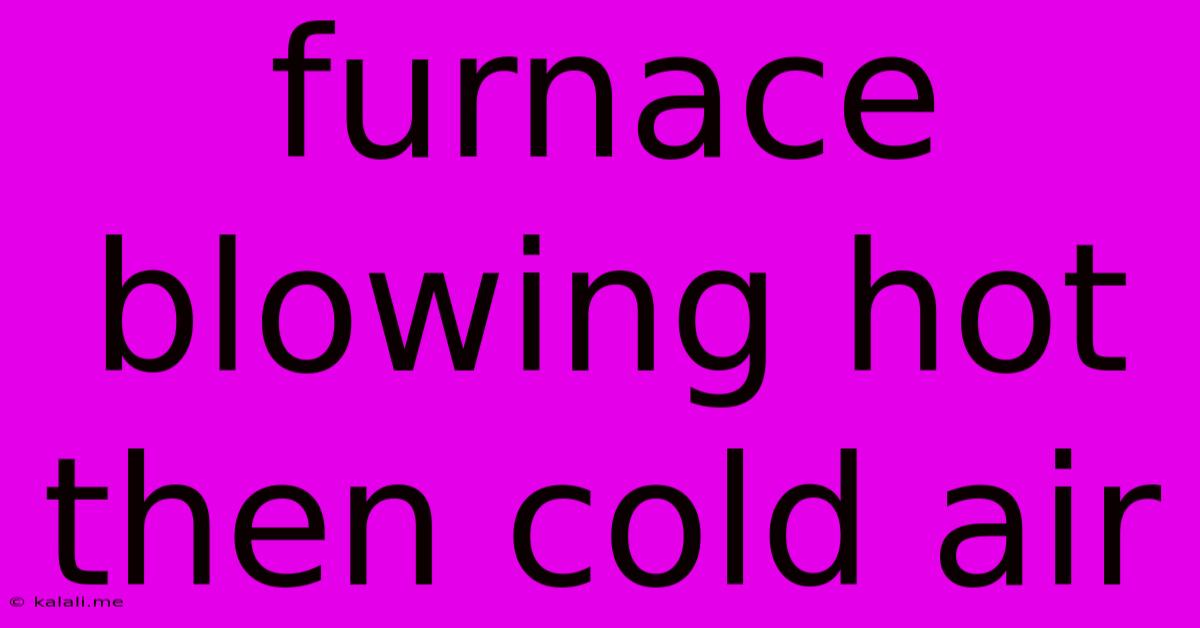Furnace Blowing Hot Then Cold Air
Kalali
Jun 02, 2025 · 3 min read

Table of Contents
Furnace Blowing Hot Then Cold Air: Troubleshooting and Solutions
Is your furnace playing a game of hot and cold? One minute you're cozy and warm, the next you're shivering under a blast of frigid air? This frustrating issue is more common than you might think and often points to underlying problems that need addressing. This article will delve into the common causes behind a furnace blowing hot then cold air, guiding you towards effective troubleshooting and potential solutions. Understanding the root cause is key to preventing further discomfort and potential damage to your heating system.
Understanding the Problem: Why the Temperature Fluctuation?
The inconsistent heating pattern – hot air followed by cold air – often indicates a problem with your furnace's ability to consistently deliver heated air. This isn't simply a matter of thermostat settings; it points to a malfunction within the furnace itself or its associated components. Ignoring the problem could lead to inefficient heating, higher energy bills, and potentially more serious, costly repairs down the line.
Common Causes of Hot and Cold Air Cycles
Several culprits could be behind your furnace's temperature rollercoaster. Let's examine the most frequent offenders:
1. Dirty Air Filter: This is the easiest and most inexpensive problem to fix. A clogged air filter restricts airflow, hindering the furnace's ability to heat the air efficiently. The furnace may cycle on and off more frequently, leading to the hot-cold cycle. Solution: Replace your air filter regularly (check your manufacturer's recommendations, but aim for at least every 3 months).
2. Restricted Airflow: Beyond the filter, other airflow obstructions can cause similar issues. Check your vents and registers for obstructions like furniture, rugs, or debris. Make sure vents are open and unobstructed throughout your home. Solution: Clear any blockages and ensure proper airflow throughout your ductwork.
3. Malfunctioning Blower Motor: The blower motor is responsible for circulating the heated air throughout your home. A failing motor might struggle to maintain consistent airflow, resulting in the temperature fluctuations. Solution: This typically requires professional repair or replacement of the blower motor.
4. Faulty Ignition System: If your furnace is struggling to ignite consistently, it can lead to intermittent heating. This could stem from issues with the igniter, gas valve, or flame sensor. The furnace may attempt to ignite, then fail, resulting in cold air bursts. Solution: A professional HVAC technician should diagnose and repair any ignition system problems.
5. Problems with the Heat Exchanger: The heat exchanger is responsible for transferring heat from the combustion process to the air. Cracks or other damage to the heat exchanger can lead to inefficient heating and inconsistent airflow. Solution: Repairing or replacing a heat exchanger is a significant undertaking and best left to a qualified HVAC technician. This is a potentially serious safety concern due to the risk of carbon monoxide leaks.
6. Low Gas Pressure (Gas Furnaces): Insufficient gas pressure can prevent the furnace from achieving optimal burning temperature, leading to fluctuating heat output. Solution: A professional needs to check and adjust gas pressure if necessary.
7. Thermostat Issues: While less common, a malfunctioning thermostat can also contribute to inconsistent heating. The thermostat may not accurately read the temperature, causing the furnace to cycle incorrectly. Solution: Try replacing the batteries in your thermostat or, if that doesn't solve the problem, consider replacing the thermostat altogether.
When to Call a Professional
While some issues, like a dirty air filter, can be addressed independently, others require the expertise of a qualified HVAC technician. Call a professional if:
- You suspect issues with the ignition system, heat exchanger, or blower motor.
- You smell gas.
- You notice unusual noises coming from the furnace.
- The problem persists despite troubleshooting the simpler issues.
Addressing the hot and cold air issue promptly not only improves your comfort but also prevents further damage and potential safety hazards. By understanding the potential causes and when to seek professional help, you can ensure your heating system operates efficiently and reliably throughout the colder months.
Latest Posts
Latest Posts
-
Does Phd Stands For Permanent Head Damage
Jun 04, 2025
-
Get The Origin Branch Of A Tag
Jun 04, 2025
-
Line 2 24 No Viable Alternative At Input
Jun 04, 2025
-
How Long Do Cooked Lentils Last In The Fridge
Jun 04, 2025
-
Can You Start A Sentence With As Such
Jun 04, 2025
Related Post
Thank you for visiting our website which covers about Furnace Blowing Hot Then Cold Air . We hope the information provided has been useful to you. Feel free to contact us if you have any questions or need further assistance. See you next time and don't miss to bookmark.